Organization of lighting in the bathroom

Lighting plays a significant role in any room. No interior is complete without suitable lighting fixtures. These include the bathroom. It is especially important here to competently dispose of the arrangement and choice of lamps of any type. In this article, we will learn how to do it correctly.
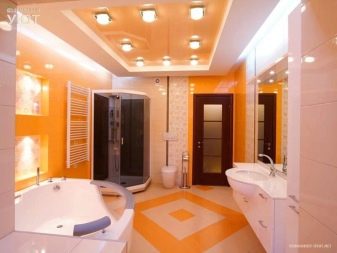

General rules for bathroom lighting
It is not so difficult to correctly place certain types of lighting fixtures in the bathroom. Any homeowner can handle this simple yet important task. Paying attention to the lighting of the specified room, there are a few basic rules to follow.
- Organizing bathroom lighting, it is advisable to adhere to the maximum simplicity and high practicality of the selected lighting devices. That is why ordinary spotlights are so often installed in the indicated space - they do not require complex installation and subsequently do not cause any problems to households.
- Bathroom lighting should be calm and peaceful. In no case should it be too bright and defiant. But you should not organize too meager, insufficient light in such a room. In such conditions, households will not get the proper pleasure from bath procedures.
- You can install lighting fixtures in the bathroom in different ways, but before that it is best to draw up detailed diagram with the future location of all devices. Observing this simple rule, it will be much easier for the owner to install lamps, making the interior comfortable and cozy.
- Before proceeding with the installation work, it should be noted that the wiring in the bathroom should be extremely hidden.
- Junction boxes, together with switches, must be installed outside the room in question. This rule is regulated by GOST, it cannot be violated.
- In order to connect cables, it is worth using exclusively sealed terminal blocks.
- When organizing lighting in the bathroom, do not use extension cords.... Instead, it is recommended to start installing sockets with a margin for all the necessary household appliances that households are used to using in the bathroom.
- The outlet in this room should be installed at a distance of at least 2.5 m from the sink... If the device is equipped with a moisture protection, the specified gap can be reduced to 60 cm.
- The lighting in the bathroom must have optimal power in accordance with the design and layout of the room.... One lighting fixture will not be enough here. Typically, the bathroom requires fixtures next to the mirror and elsewhere on the walls / ceiling.
- Light should be in all functional areas of the room, otherwise it will be inconvenient to use them.
- Optimal light distribution - one of the most important rules.
- It is not recommended to install a single lamp directly above a sink with a mirror. In this case, the reflection will be noticeably distorted. It will be possible to avoid such a problem if you choose the side placement of the devices either on top and on the sides.




Distributing lighting in a bathroom is easy. The main thing is to remember about the safety of household members, the ease of use of lamps and their optimal location.
Backlight types
For the arrangement of the bathroom, you can give preference to lamps of different types. Each of them has its own peculiarities of installation and placement. Let's list what types of lighting are appropriate for location in the bathroom.
- Ceiling. A simple, common type of backlighting. Any bathroom is usually equipped with at least one lighting element of this type. Ceiling lights can be a chandelier or spotlights.




- Wall. This type of lighting is especially relevant when it comes to organizing the space around the mirror above the sink. Wall lighting not only makes the environment brighter and more attractive, but also successfully serves as a separator of existing functional areas.


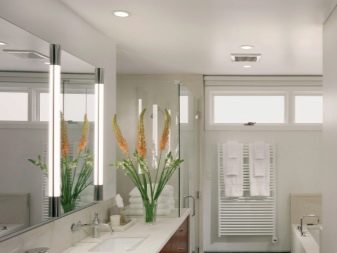

- Floor... Lighting devices of this type can be considered decorative. With their help, it is possible to bring interesting notes and zest to the interior. In this way, you can effectively visually expand the available space. Often, floor lamps are installed in the front of the steps, which looks very stylish and elegant. With the help of such devices, it is even possible to divide / zone the space.
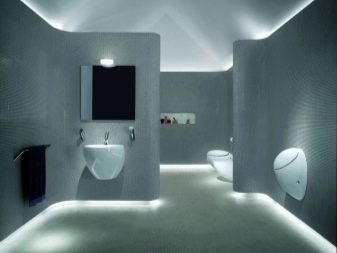



- Desktop... This type of lighting is used a little less often in bathrooms. It is possible to put a lamp of this category only on a free table, bedside table or cabinet in the room. On rare occasions, this backlight gets the main focus and makes a special sense.
Each of the listed types of backlighting it is permissible to use it as a decorative, working element or a source of directional light. Often times, all types of lighting can be combined with each other to create a pleasant and cozy atmosphere in the bathroom.




Types of lighting devices
The choice of suitable lighting devices is complicated not only by their functionality, but also by their direct appearance. The range of such products is huge. Many different lamps can be found in stores. Let's get acquainted with the list of the most relevant and widespread options.
- Chandeliers. In the room under consideration, non-standard models made in the form of a "tablet" are often installed. They are flattened and pressed as tightly as possible to the surface of the ceiling base. On sale you can find chandeliers on special brackets or chains. This is usually the center light.




- Sconce... Exquisite wall lights. They are presented in the widest range. They are installed on the walls. The main thing is to correctly find the optimal place for such a device in the bathroom - it should not interfere with anyone.




- Floor lamp. Available in a wide range. They can have a variety of sizes and heights. These are usually floor lighting fixtures. More often they are designed for a room of sufficient square - in a very small bathroom, such a product may not find free space.




- Spotlights. One of the most popular and demanded lighting fixtures. They can be built into a single or multi-level stretch ceiling structure. You can install them in other bases as well. Spotlights are often complemented by a special rotary mechanism, due to which households can easily adjust the direction of light in the bathroom, which is very convenient.




- Spots. Special suspension systems, in which several lamps are provided, attached to a strong rod. These devices also boast a rotary mechanism, which makes them very practical and functional.




- Table lamps... The tabletop type of lighting in the bathroom is not used as often, however, it is sometimes resorted to to complement the bedside tables or table, if any, with light. Lamps should be selected exclusively waterproof (like other lighting devices) so that they are not damaged. More often desktop devices are replaced with wall-mounted ones - they take up less space.
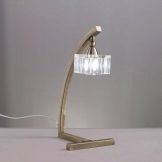



- LED Strip Light. Recently, this lighting device is one of the most popular and stylish. Its installation is resorted to in any room - and in living rooms, and in halls, and in kitchens. The bathroom is no exception.
With the help of an LED strip, you can visually divide the space, build a spectacular backlight for any foundations and structures. The color of the ribbon can be very different - it all depends on the color solutions of the situation as a whole.




Characteristics of lamps
Bathroom lighting fixtures can be equipped with different types of lamps. The latter can have many differences and characteristics. Let's get acquainted with them.
Incandescent lamp
Other name - light bulb "Ilyich". It is inexpensive, it is found in many retail outlets, but for the bathroom it is considered not the most successful solution. These types of bulbs do not tolerate high humidity levels - because of it, products can burst (when moisture gets on the surface of a hot lamp). The typical lifespan of such a light source rarely exceeds a thousand hours.
The lamps under consideration quickly and seriously heat up, but the luminous flux at the same time emit a weak.

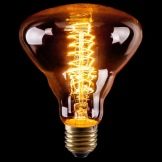


It is not recommended to choose these bulbs if there are textile or plastic lampshades nearby. This can cause the plastic to melt, and the fabric is at risk of bursting.
Halogen
In most cases, these bulbs are chosen for spotting. Such products boast a more significant luminous efficacy in comparison with the incandescent lamps described above. On sale, halogen copies are found with enviable regularity. They are designed to operate at 220 or 12 watts. In the second case, you will need to install a transformer.
Such bulbs can emit both warm and neutral light fluxes. This factor will directly depend on the power level of the electrical appliance.




Luminescent
Modern energy saving lamp. It is characterized by excellent light flow.A fluorescent light bulb works seamlessly in a wide variety of conditions, and a wet bathroom is no exception. These copies serve for years if there is a stable voltage in the network.
There are bulbs of various shades. With their help, it is possible to form a large number of lighting effects. You can also find fluorescent lamps in different designs. So, compact and linear versions are sold. Different lamps can cover different areas. Such light sources work without emitting any noise.
The main problem that can occur when working with such lamps is the need for flare-up. This may take about 2 minutes. Lowering the temperature values for fluorescent lamps is destructive. When using such products, one must remember that a burned out or damaged light bulb cannot be simply thrown away with the rest of the garbage - it needs specialized disposal.
Energy-saving lamps predominantly emit cold light, slightly less often neutral. They cover the warm spectrum in a very small ratio. Such lighting does not seem to all users to be cozy and comfortable, so choose a cold light carefully and deliberately.
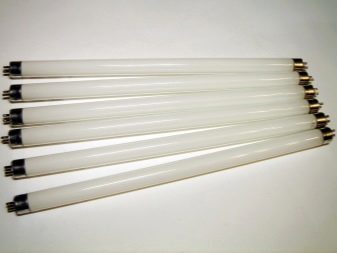



LED
LED or LED bulbs are recognized today some of the most popular. They are in demand and are in great demand, since they attract the buyer with their efficiency and impressive service life. A high-quality lamp of this type can work over 50 thousand hours. They can also be screwed into an ordinary base, so they are suitable for replacing any other light sources.
LED lamps boast such significant advantages:
- they are environmentally friendly;
- are characterized by high-quality luminous flux;
- are found on sale in many retail outlets;
- consume little electricity.

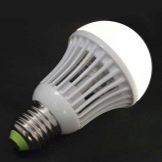


True, these bulbs are more expensive than the options listed above. Because of this, many buyers refuse to purchase them. It is also necessary to take into account the fact that the service life of LED lamps declared by the manufacturer is not fulfilled in all cases (as a rule, due to voltage surges).
Calculation of the number of light sources
The correct calculation of the number of light sources for the bathroom will directly depend on its quadrature. There should not be too many or few devices - in such an environment, households will not be too comfortable. For this reason, you should be careful about the optimal number of luminaires. So, if we are talking about a modest room in 4 sq. m. or 5 sq. m., then a single central device will be enough here, and with it 2-3 wall lamps. For a small area, this amount is enough.
If the bathroom in the dwelling has impressive dimensions, then zone lighting will be appropriate here.... It will make the room more comfortable to use and help to highlight specific functional areas. Here you will have to decide on the number and power of light sources even before the start of finishing work. Only if this simple condition is met, it will be possible to make high-quality wiring that meets all standards.
To make it easier to calculate how many light sources are needed for a large bathroom, should be allocated for every 1.5 sq. m. for 1 device... Often, for a more aesthetic and neat look, they are installed on the ceiling in a checkerboard pattern.




Location
The location of all lighting fixtures in the bathroom must be distributed correctly. As mentioned above, it is advisable to draw up a detailed diagram of the future placement of the luminaires in advance. You can prepare it, taking into account the following features:
- how many square meters are in the room;
- are there niches with several levels or a stretch ceiling;
- are there functional areas;
- what is the style of the interior and in what colors it is sustained.




Designers recommend placing devices in a room based on the specific levels at which the fixtures are located.
- Ceiling lamps are usually located at a height of 180 cm or more... Here you can choose a device for every taste, but the modern version is especially popular - the starry sky. A chic crystal chandelier is also suitable, if the size of the room allows. Spotlights can be placed in the upper part - these are win-win options. They look spectacular both with a stretch ceiling and any other type of ceiling.
- If you want to hang a chandelier right under the ceiling, designers are advised to choose minimalistic models, for example, from aluminum. Such products are good for their original design and shiny surfaces.
- It is important to correctly position the luminaires in the workspace. Do not leave a mirror and a sink without lighting devices. The latter is best supplemented with light in 3 directions (the upper edge should not be touched). Above the bathroom itself, you can fix point-type devices or place a tall floor lamp on a leg with a lampshade next to it.
- The floor arrangement of light sources is also appropriate. Here the best solution would be high-quality sealed low-power lamps.
When placing lamps in the bathroom, care must be taken that the luminous flux does not create glare and does not fall directly on reflective surfaces. If you plan to put devices with colorful shades, then they should not be placed near the mirror, otherwise the reflection will be distorted. It is allowed to install mobile lamps to place them on cabinets, niches and shelves.




Safety regulations
When you are organizing lighting in a bathroom, you must remember that this is where electricity and high humidity meet, so safety rules cannot be neglected. It is important to adhere to a number of guidelines listed below.
- It is necessary to competently and carefully work out the lighting scheme in the room where the water procedures will be taken. It is advisable to contact a specialist.
- You should buy and install only those lighting fixtures that are not afraid of high humidity, since the bathroom cannot do without it.
- Parts of luminaires made of metal must be properly protected from corrosion.
- Luminaires in the bathroom or shower should have a power not exceeding 12 watts.
- Care must be taken to minimize the risk of water splashing on appliances on ceilings or walls. It is strongly discouraged to install open incandescent lamps here, since heated products can burst and scatter fragments around the room upon contact with water.
- In the room in question, there is no place for exposed wiring, tees and extension cords.

Successful examples
Don't underestimate the importance of lighting fixtures in creating a harmonious bathroom interior design. Often, a properly selected lamp becomes a chic addition to the furnishings or its bright accent. Let's consider several successful and attractive examples of the placement of lighting devices in the room under consideration.
- In the bathroom, designed exclusively in classic white colors, it will look great round ceiling lamp with a snow-white shade and a red frame. Red notes should be reinforced with decorations of the same color, for example, red flowers on the pedestals under the mirror.


- Modern bathrooms in black are trendy. Against such a background, contrasting snow-white plumbing and large mirrors look especially impressive and stylish.
Popular recessed spotlights on the ceiling will harmoniously fit into such an environment.


- A lot of chaotically placed spotlights will be a great addition to the interior. black and white room in a modern style. It is advisable to place furniture with glossy surfaces and shiny fittings here.
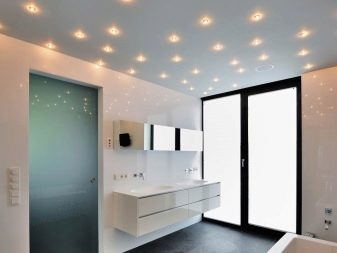

- In an unusual and rich room with a burgundy stretch ceiling, cream tiles and mosaics with the same colors, you can install ceiling chandelier in classic style... To make the environment even brighter and more interesting, you can install blue LED bulbs against a background of mosaic surfaces.


For information on how to make the right lighting in the bathroom, see the next video.








